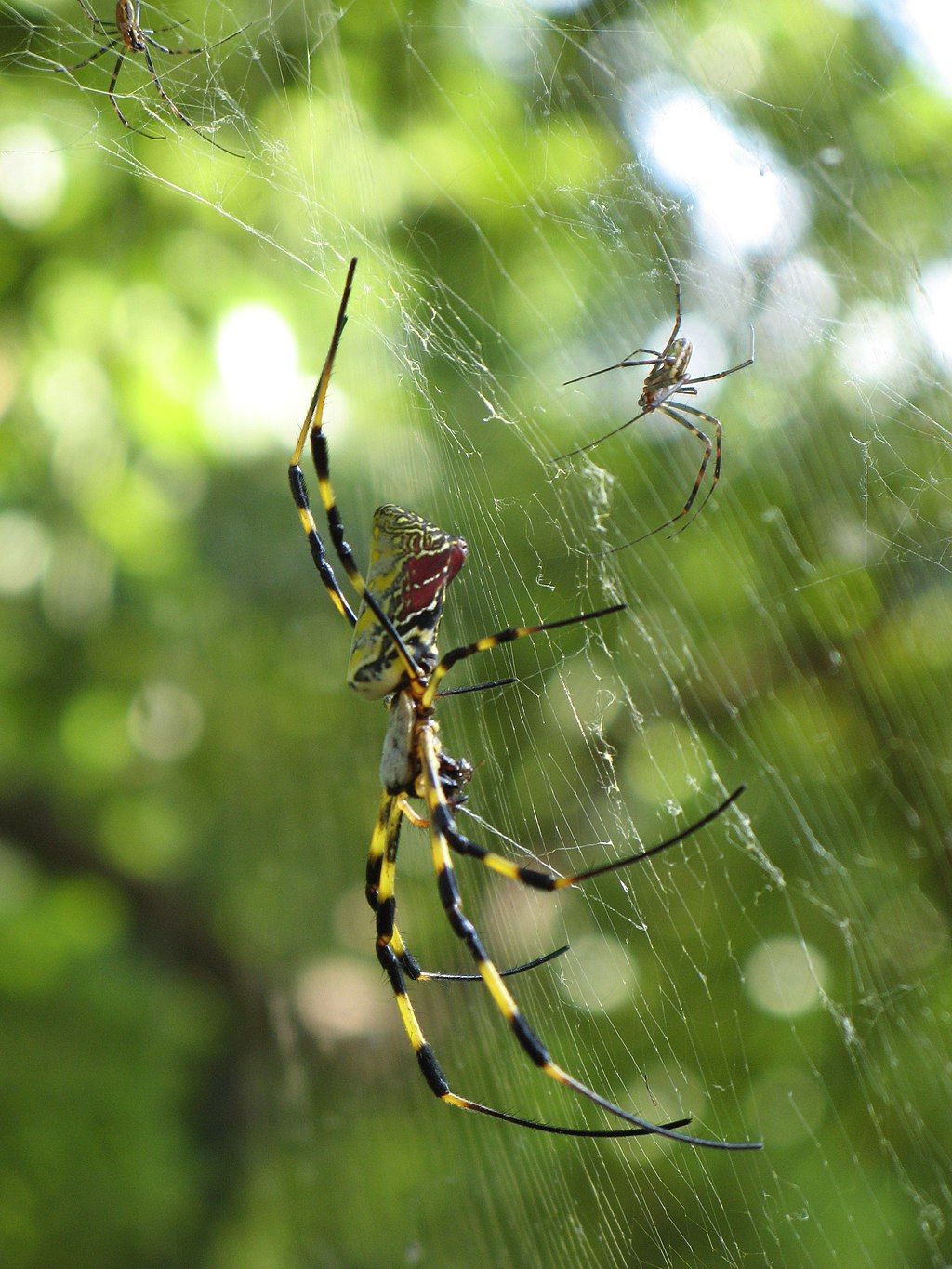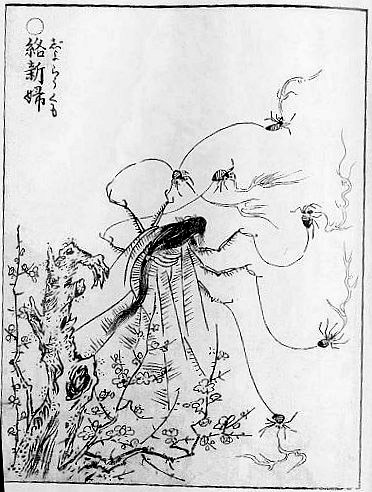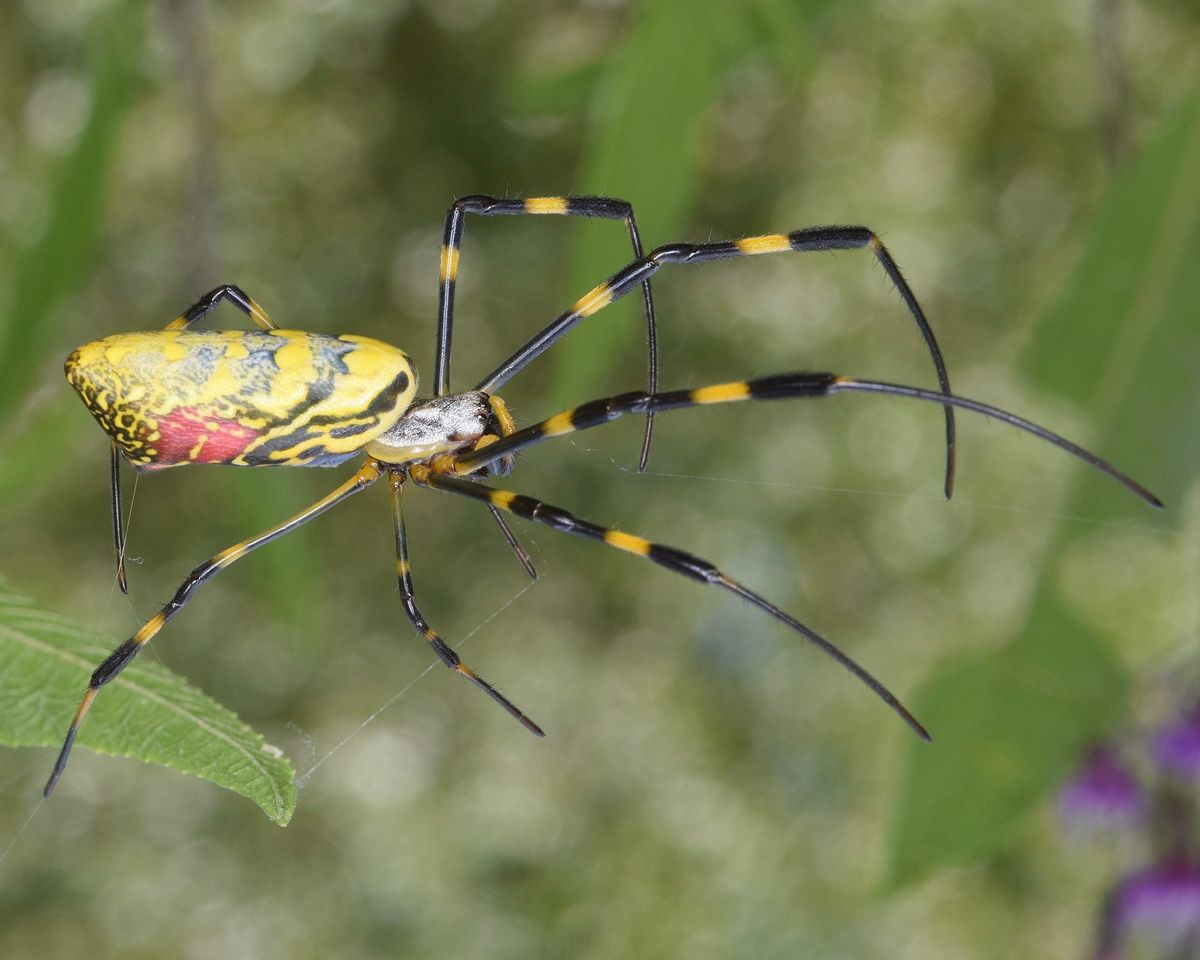In Japanese folklore, the Jorōgumo is a legendary spider that can change its appearance into a beautiful woman, seducing and devouring men she captures in her silky web. The Joro spider — so named after the Jorōgumo — is a strikingly patterned spider that has equally seduced American arachnologists since its first arrival on the continent nearly a decade ago.
As of this writing, the invasive palm-sized spiders, which are endemic to Japan, have been reported in at least 25 counties across Georgia and South Carolina. Scientists suggest they’re here to stay.
First spotted in Georgia in 2013 and genetically confirmed two years later, the Joro spider has since spread across the state and other parts of the Southeast. Now, research from University of Georgia (UGA) published in March 2022 suggests that the spiders may spread throughout the Eastern Seaboard.
“People should try to learn to live with them,” said Andy Davis, corresponding author of the study and a research scientist in the Odum School of Ecology at UGA, in a news release. “If they’re literally in your way, I can see taking a web down and moving them to the side, but they’re just going to be back next year.”
https://www.youtube.com/watch?v=6bFQdQcAZtk
As parts of the country can one day expect to live alongside these arachnids, here is what we know about the 3-inch-wide spiders.
The Joro Spider at a Glance
Going by the scientific name Trichonephila clavate, the Joro spider measures about the same size as a banana spider with a body size roughly 2 inches. Females have yellow and blue-black stripes on their backs with bright red markings on their undersides. Their male counterparts tend to be a shade of brown. Their three-dimensional webs are golden in color, and tend to be higher off the ground than those of other, closely related spiders.

The Joro Spider is Likely Not Leaving the U.S. Anytime Soon
To predict the potential range of the Joro spider, researchers at UGA analyzed records from iNaturalist, a citizen scientist endeavor that tracks sightings of animals across the nation and logs data on various species. Additionally, they conducted tests to determine how well the spiders could tolerate cold, which included data on their metabolic, heart, and survival rates during a freeze. This information was then compared with that of the golden silk spider, a cousin of the Joro spider that is native to the tropics but has been found in the Southeast since the 19th century. Because of its vulnerability to the cold, the golden silk spider has not moved past its southeastern range.
But that’s not the case with the Joro spider. Despite their similarities, the Japanese species has
double the metabolism of the gold spider, a 77% higher heart rate, and can survive a brief freeze — all of which indicates it will better survive in cold environments.

How Did the Joro Spider Arrive in the U.S.?
Found throughout most of Japan, the Joro spider is used to a climate similar to much of the Eastern Seaboard. It is thought that specimens initially arrived in the U.S. by way of shipping containers and have since hitched rides on cars and in luggage.
“The potential for these spiders to be spread through people’s movements is very high,” said study co-author Benjamin Frick. “Anecdotally, right before we published this study, we got a report from a grad student at UGA who had accidentally transported one of these to Oklahoma.”
How Are They Able to Spread so Quickly?
When not hitching a ride on humans, the Joro spider uses its silk to let itself be carried by the wind, in what is known as “ballooning.” Hatchlings emerge in the spring and shoot off to new locations on wind-carried strands of gossamer parachutes, oftentimes to find potential mates.
Do Joro Spiders Bite, and Are They Venomous?
Experts note that Joro spiders won’t bite a human unless they are cornered. Even then, their fangs aren’t large enough to break human skin. Most spiders are venomous and use it to kill prey, but the venom of Joro spiders is generally harmless to people and pets, although some may be allergic.
Will These Arachnids Impact Local Ecosystems?
Researchers say they have not yet noticed negative effects on native species and may even see some benefits to the Joro invasion. Observational data has shown that the spiders can coexist with native species and have reportedly woven webs close to, or even attached to, those of other weaving spiders.
Unlike native spiders, Joro spiders feed on adult brown marmorated stink bugs, an invasive pest that infests houses and damages crops, and because wasps and birds like to eat Joro spiders, they provide an additional food source to native predators. It is thought that Joro spiders may also suppress populations of mosquitoes and biting flies.
If anything, Joro spiders may be a nuisance as their webs are large and their population is currently booming. However, researchers say that nature will eventually balance such population concerns.
Here’s What To Do if You Come Across One
Nothing. Experts note that there is no need to harm the spiders and efforts to eradicate the species would be in vain. If the spider is too close for comfort, simply shoo it away with a broom.
Sightings, including the date and location where the spider was seen, can be reported to Richard Hoebeke. Georgia Museum of Natural History collections manager, at rhoebeke@uga.edu or through iNaturalist.
Sources
Beeson, Leigh. “Joro Spiders Likely to Spread beyond Georgia.” UGA Today, 3 Mar. 2022, https://news.uga.edu/joro-spiders-likely-to-spread-beyond-georgia/.
Davis, Andrew K., and Benjamin L. Frick. “Physiological Evaluation of Newly Invasive Jorō Spiders ( Trichonephila Clavata ) in the Southeastern USA Compared to Their Naturalized Cousin, Trichonephila Clavipes.” Physiological Entomology, Feb. 2022, p. phen.12385. DOI.org (Crossref), https://doi.org/10.1111/phen.12385.
Gavrilles, Beth. “Like It or Not, Joro Spiders Are Here to Stay.” UGA Today, 26 Oct. 2020, https://news.uga.edu/joro-spiders-are-here-to-stay/.
"Like It or Not, Joro Spiders Are Here to Stay.” UGA Today, 26 Oct. 2020, https://news.uga.edu/joro-spiders-are-here-to-stay/.
“UGA Scientists Confirm First North American Record of East Asian Joro Spider.” UGA Today, 17 Mar. 2015, https://news.uga.edu/first-north-american-record-east-asian-joro-spider-0315/.
Joro Spiders Cloak North Georgia in Their Webs. https://newswire.caes.uga.edu/story/8746/spiders-spiders-everywhere.html. Accessed 7 Mar. 2022.
“Jorōgumo.” Wikipedia, 7 Mar. 2022. Wikipedia, https://en.wikipedia.org/w/index.php?title=Jor%C5%8Dgumo&oldid=1075789939.
“Observations.” INaturalist, https://www.inaturalist.org/observations?taxon_id=904334. Accessed 7 Mar. 2022.
“Photos of Jorō Spider (Trichonephila Clavata) · INaturalist.” INaturalist, https://www.inaturalist.org/taxa/904334-Trichonephila-clavata/browse_photos. Accessed 7 Mar. 2022.
Schoch, Conrad L., et al. “NCBI Taxonomy: A Comprehensive Update on Curation, Resources and Tools.” Database, vol. 2020, Jan. 2020, p. baaa062. DOI.org (Crossref), https://doi.org/10.1093/database/baaa062.
The Joro Spider Is Here to Stay. www.youtube.com, https://www.youtube.com/watch?v=6bFQdQcAZtk. Accessed 7 Mar. 2022.
